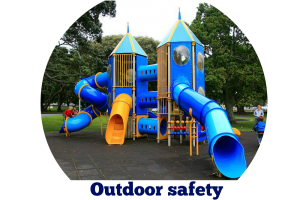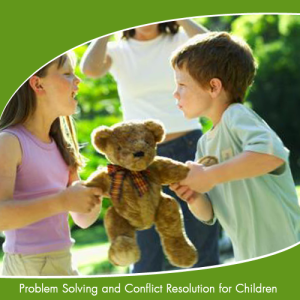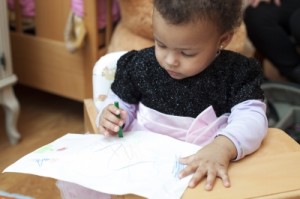In our bid to get our children more outdoor play, we must also safeguard them against seemingly harmless outdoors. This article is does not intend to prevent you from sending your child outdoors to play, but to ensure that when you do so, proper safety precautions are undertaken to everybody has a good time.
Choosing age appropriate toys for kids of all ages
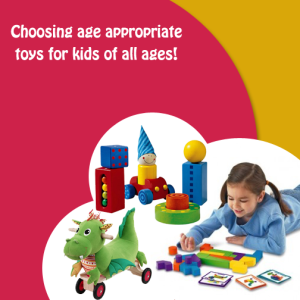
Before you set out to find the perfect toy for your child, you must understand that the best toy for the child is sitting right at home. That’s you! Yes, you are your child’s most interesting and nurturing toy in the whole wide world. But there are times when you can’t be with him/her full time. That’s when the other toys come in. But these should be reserved for play only when you can’t be around to play with your child.
Toys and games for newborn and babies:
You are your child’s best toy and playmate at this stage. She enjoys watching your face, movements, expressions and enjoys feeling your loving touch. Since babies at this age aren’t mobile yet, their eyes and ears are their window to the world. So make sure you talk to your baby as you move around the room. Get closer to the baby as often as possible as newborns can’t focus beyond 30 cms in the first few days of their life.
Babies at this age also love contrasting colors. So, getting colourful soft toys are a very good idea. They also love listening to sounds around them. Introduce them to music through musical mobile tunes or a baby rattle.
Once the baby learns how to reach for toys, you could get some interesting Knicks and knacks from around the house itself. Colorful paper and cloth books are a great option too!
Toys and games for preschoolers and toddlers:
Children at this age have started walking so pull-along toys are a great investment. To nurture the love of books, introduce soft cloth books with lots of images. Your child is also learning cause and effect so a wonderful game to play is peek-a-boo. Other options include a jack-in-the-box.
Provide plenty of outdoor play opportunities like a visit to the sandpit.
Your toddler will love playing with colors at this stage. Although they can’t hold a crayon yet, you could get toxin free finger paint and set them up on a play mat lined with newspapers. Sit back and watch as your toddler feels the gooey paint through her fingers and makes pretty art work on the paper.
Safe fun with water at this stage is an instant hit. If the weather is warm you could set up a paddle pool. In cold climes, stick to bath times for fun with water. Get lots of colourful squeezy toys and throw them in the bath tub with your child.
*Note: Never leave a child unattended near any water body, no matter how shallow.
Toys and games for school-age children:
Your child is completely capable of telling you which toys he/she finds interesting. You can use that as a guide while choosing toys.
Most children at this stage are keen on the latest technology toys. In today’s day and age it is not possible to completely exclude these types of games. Choose them wisely and weed out anything with violence in it. Limit screen time from early on.
Also popular at this age are construction sets, board games and art and craft toys. For outdoor play, you must invest in a safe bicycle. Other options include roller skates, skipping ropes and cricket.
Spending time playing with your children still rules the roost, even at this stage. So make sure that toys are not a substitute for quality time they could have spent with you.
What is causing your child’s cough?
 Cough and cold are the most common afflictions of children both young and old. Preschoolers suffer from coughs 3-8 times a year and older children up to 4 times. But there is a lot of confusion surrounding coughs and why they are caused. Here’s an article hoping to clear away some of those misconceptions and an easier (read less worrying) recovery.
Cough and cold are the most common afflictions of children both young and old. Preschoolers suffer from coughs 3-8 times a year and older children up to 4 times. But there is a lot of confusion surrounding coughs and why they are caused. Here’s an article hoping to clear away some of those misconceptions and an easier (read less worrying) recovery.
Coughs are usually caused by viruses. It is what we generally refer to as a viral infection. Since viruses are microorganisms that are neither alive nor dead (seriously!), it is impossible to eradicate them. Antibiotics are of no use on them. So basically, the infection has to run its course. It may last anywhere from 5 days to 12 days. A typical infection throws up symptoms like a head cold, runny or stuffed nose, sore throat, cough and sometimes a fever as well. The paediatrician may prescribe medicine to allay the symptoms of the viral infection (cold, cough, etc), but there is no cure for the infection itself.
However, there are cases when cough can be caused by allergies. If your child is allergic to dust mites, pollen, animal dander, etc, the cough may present itself whenever there is contact with the allergen. The only recourse is to administer antihistamines prescribed by your child’s paediatrician.
In rare cases, Pneumonia, an infection of the lungs can cause a persistent cough. It is also accompanied by difficulty breathing, a cold, fever body aches and chills. If you suspect pneumonia, it is a good idea to take your child to the paediatrician.
Bronchitis is another rare cause of a persistent and hacking cough several weeks after a viral infection. Bronchitis is an infection of the tubes carrying air to the lungs. This too can be either viral or bacterial. If it is bacterial, antibiotics will work. The paediatrician should be able to tell you whether the infection is viral or bacterial.
When to call a doctor, when a child has cough:
If your child is less than 3 month old
If breathing is laboured
Is coughing mucus that is streaked with blood
Is younger than 6 months and has a fever of 101 or above
Is over 6 months and has a fever of 103 and above
Is coughing after choking on something
Coughing causes vomiting
In any case, avoid administering any medication till you have prior permission from the doctor. Over the counter cough medicines do more harm than good. Mixing 2 or more types of cough medicines can cause a fatal combination in some cases.
Till the doctor is able to give you a definite course of action, try some simple home remedies for relief. Honey works wonders on cough. Try it!
Early warning signs of a learning disability
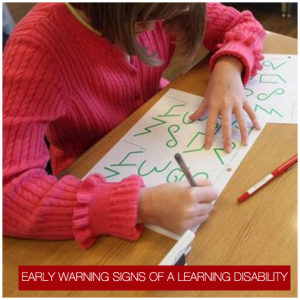 Can I tell if my child has learning disability?
Can I tell if my child has learning disability?
Children till the age of 5 learn skills at different rates. If a child is adept at speaking, he may be slower to comprehend numbers. Similarly, a child who is adept at physical manoeuvres and play may learn the alphabet later than others. This varying rate of learning new skills can throw parents off the correct way to diagnose if there is a problem.
Learning disability falls into 3 wide categories:
Speech and language problems
Reading writing and math problems
Coordination, motor skills and memory problems
However, sometimes the disability is quite apparent such as dyslexia (reading impairment) or dyscalculia (math solving impairment).
What exactly goes wrong in a child with learning disability?
A child with learning disability who has a normal IQ, like any regular child, cant process accurately information that gets passed on from the eyes and ears to the brain. The child knows what he/she wants to accomplish, but can
Problem Solving and Conflict Resolution for Children
As a parent how did you learn to resolve conflicts? Doubtlessly, your biggest influencers were your parents. You learnt your early lessons from them and unknowingly emulated their responses and attitudes when resolving conflict. Now, these are a part of your psyche and intellect more than you would ever want to admit.
Conflict resolution is not like math. It is an art that needs to be experienced, interpreted and learnt in our own unique way. When it comes to children, it is best to let them resolve conflict in their own way, albeit, with a little support from you. Here are a few guidelines that will slowly, but surely help you and your child learn conflict resolution at every level, whether it is for a very young child or an older child.
- Let them resolve conflicts. Don’t do it for them
It is challenging for any parent to hold back when a child is trying to snatch a toy from another child. After all, you want to instil the spirit of sharing early on, right? Well, this may not be the right way to do it. It is easy to swoop in and demand that your child share the toy or even take sides in your attempt to dissolve undesired situations that result in crying and heartbreak.
But intervention at this stage can prevent the child from learning it to resolve it in his own way. He will always look to you for support (if you support him) and look away from you (if you take the other child’s side). Both are equally damaging.
Next time you are faced with a similar scenario, try this:
If your child cries for a toy that is with another child, express empathy. “I know you are upset that you can’t play with the teddy now”. At the same time, offer choices to resolve the conflict. “Do you want to ask Amy if she can share it the teddy with you for some time?”
- Provide safe environment for conflict resolution
If a conflict resolution scenario is getting out of hand and you suspect it will result in a physical battle, it is okay to physically remove your child from the scene and explain that hitting is not allowed. Children need us to set limits when it comes to emotions that lead to physical harm. A respectful discipline option may not work in this scenario.
- Don’t shame, lecture or use an angry/surprised tone with a child in conflict
Children are even more sensitive to others than we are. So when your child hits somebody, don’t shame him by pointing out the obvious. “Look, how you hurt Arjun! He is so sad!”
The hitting was more of an uncontrolled and impulsive reaction than the hate for Arjun. Understand that the child has a wide range of emotions running through him/her right now,
Keep a calm voice. The child is already on a emotional high and doesn’t need you to contribute to it.
There is a tremendous amount of excellent information on these techniques and teaching them to children of all ages. Google RIE and you will find tools and articles helping you to bring up self sufficient children. Make them part of your day, and a part of your child’s life and they will grow in depth and confidence.
Fostering a Love for Learning in your Child
So, your child does not sit in one place when it’s time for homework? Let us rewind back to the time when the child was a toddler. If you spend a fair bit of time with the child early on, reading, telling stories, writing or just listening as the child was trying to piece sentences together, chances are, you are not going to have to deal with this problem later. If you have been able to get the child into a routine of reading or any other form of age-appropriate learning, the love for learning has in all likelihood, already developed. The child now sees ‘studying’ to learn new things as a way of life and does not find it a chore to sit for completing homework.
The more involved a parent is in the child’s everyday efforts at learning something new, the more likely the child might be to take to learning naturally. Being appreciated for learning a new thing fosters the will and ability to learn more.
So, how does one inculcate the habit of ‘homework’ even though there is no homework when the child is in pre-school? Here are some tips for parents to experiment with:
a) Invest in Workbooks: Not all parents are internet savvy and not all might want to download worksheets from popular websites or from the school portal. If you are one of those, invest in buying some good workbooks from book shops. Sit the child down everyday, at least once a day, even if it is for 15 minutes and get the child to complete a set of chosen pages.
b) Allow the child to choose: Dictating the routine is important but dictating what a child needs to study when is not critical in pre-school. Allow the child to choose one of a few types of things to do. You might be surprised how soon a child’s talent for words or numbers is apparent. Encourage the child by awarding stars or paste stickers to acknowledge a job well done.
c) Make learning integral to everyday activities: Holidays don’t have to mean no workbooks. There are times when holidays are packed with social visits but then there are some when the child has ample time. Weekends can be fun learning time when the child is experimenting with cut vegetables or fruits or flour shapes or other such indulgences that need a lot of time and hence are tough to manage on a weekday.
d) Make every travel a learning experience: We learn a lot while traveling. It is important to make that learning process conscious for the child too. Every travel can include an opportunity to play games that are portable and fun.
e) Be excited about learning: If you catch yourself making statements like ‘No homework today! Yeah!’, you are indeed, making a child believe that getting homework is not cause of celebration but lack of it is. Who then, is, instilling the feeling in a child that homework is unwanted and is a burden?
A child learns best via role modeling. Love to learn and a child will follow suit.
Re-published with permission from the blog of ParentEdge, a bi-monthly parenting magazine that aims to expose parents to global trends in learning and partner with them in the intellectual enrichment of their children. This blog was written by Namrataa Arora Singh. After 14 years of working as a Talent Development expert in the Corporate world, Namrataa Arora Singh decided to re-invent her career. A Certified Professional Coach (CPC) from the International Coach Academy (Australia), Namrataa has been coaching women across the globe for the last 6 years.
Image Source: [freedigitalphotos.net]
When To Say No To Your Children
 For a majority of the parents out there, saying no to your little ones can be a hard task. Even as they get older, saying no to their wants can be difficult. Many parents avoid saying no to their children because they don’t want to be considered unfair, mean or a bad parent. Some parents believe that children should have what they want as we only live once and we should be enjoying life to the fullest. Today, not all parents are able to keep up with the demand of their children. The cost of living is always going up as with the luxuries that we all want and need. We have all these new and advanced toys that come with a high price tag.
For a majority of the parents out there, saying no to your little ones can be a hard task. Even as they get older, saying no to their wants can be difficult. Many parents avoid saying no to their children because they don’t want to be considered unfair, mean or a bad parent. Some parents believe that children should have what they want as we only live once and we should be enjoying life to the fullest. Today, not all parents are able to keep up with the demand of their children. The cost of living is always going up as with the luxuries that we all want and need. We have all these new and advanced toys that come with a high price tag.
It is important that you keep your ground with your children and set boundaries. There will be many times that you are going to have to say no to your child’s wants. Giving in to your child is not always a bad thing as long as you keep it under control. It is okay to say yes, but don’t say yes every single time. Saying no will help your child realize later in life that you don’t always get what you want. Be up front and honest with your child and let them know that you can’t always afford to buy them everything they want.
When telling your child no when they want something, make sure to let them down in an easy way. Again, be sure to be honest and explain to them why you are saying no. Tell them no in a nice and polite voice. Don’t scream or raise your voice unless your child gives you reason to raise your voice. Once you say no, stick to your grounds. Don’t back away and change your mind. Keeping your ground will give your child a feeling of security which is needed. Keeping calm will rub off good behavior on your children. After letting your child down, offer them something in exchange. Offer them to make their favorite dinner, go to the park, watch a movie, etc.
Image Source: [freedigitalphotos.net]
When They Are Bored, What Then?
 If you live with children, you have probably heard the phrases “I’m bored” or “What Can I Do, I’m Bored?” a few dozen times, if not more. You will definitely hear it quite often if you have a large family with more than one child. Even when they have someone to play with, they are going to think they are bored at one time or another. If you are busy and can’t entertain them, designate them to clean their room. Tell them they can do some extra chores. Sometimes this will get them off your back. They will either complain about having to clean and walk off or throw you off and want to help you clean. If they are that bored, then you might get some extra help for the day.
If you live with children, you have probably heard the phrases “I’m bored” or “What Can I Do, I’m Bored?” a few dozen times, if not more. You will definitely hear it quite often if you have a large family with more than one child. Even when they have someone to play with, they are going to think they are bored at one time or another. If you are busy and can’t entertain them, designate them to clean their room. Tell them they can do some extra chores. Sometimes this will get them off your back. They will either complain about having to clean and walk off or throw you off and want to help you clean. If they are that bored, then you might get some extra help for the day.
If you want to entertain them, there are some things you might be able to do just in your city or town. How expensive it will be to entertain them is going to vary depending on where and what you do. What you do also depends on the age of your children.
A roller rink is an option if you have one where you live. Usually they are affordable and kids love them. If you don’t want to chaperone and they are old enough to drop off, make sure you give them money for admission, skate rental, change for a locker and money for something to drink if they have been fed. The older children usually think the roller rink is the place to go, especially when other school kids are there too!
If they don’t want to skate, depending on their age, they will probably want to go see a movie. Make sure you feed them before though, movie theatre food can be expensive if you are treating multiple children. This usually is one place you can’t go wrong, unless there are too many people there and you can’t find a seat.
Other ideas would be to look online for events in your area. Depending on where you live, your city might have some sort of local website that is updated with events. You also could go on a picnic to the park, take a trip to the mall for some window shopping, go fishing, take a class, etc. There are many things you can do when your children are bored, just have to find what works best for you and your pocketbook.
Image Source: [freedigitalphotos.net]
Tips To Help Teach Your Children Their Numbers
 If you have a toddler, they are probably trying to learn how to count. If they are not trying to learn to count, they are definitely learning how to say different numbers. Most will learn at around three that they are three years old. They might not know what it means, but they remember the number. You will want to help them want to learn numbers so it comes easy to them once they start going off to school. Remember, you are your child’s first teacher. Below are some creative ideas to help teach your child count numbers.
If you have a toddler, they are probably trying to learn how to count. If they are not trying to learn to count, they are definitely learning how to say different numbers. Most will learn at around three that they are three years old. They might not know what it means, but they remember the number. You will want to help them want to learn numbers so it comes easy to them once they start going off to school. Remember, you are your child’s first teacher. Below are some creative ideas to help teach your child count numbers.
Read books on counting. There are many of these books in your local bookstore, libraries, EBay, etc. These are fun and a majority of the books you find will have great images to go along with the book to keep your child’s interest. Kids love books so stock up! If you are really creative, you can make a counting book with your child.
Use flashcards. You can either buy some cute expensive cards with pretty pictures, some cheap flash cards with just numbers or just make your own. Flash cards have been used for years. They work! You can also go to a school supply store and get some writing tablets that allow your child to trace numbers and also the alphabet.
When asking “How Many?” start with small numbers. Even very young toddlers will start memorizing the numbers one, two, or three. So spend a lot of time counting up to three objects at first. Eventually, your child will be able to say he or she has 2 hands, 2 feet, etc.
Another option would be blocks, depending on their age. Small children love blocks. Many of the small wooden blocks that you can buy at the toy store will have numbers painted on them.
Find something that both you and your child will enjoy doing. There are many different ways you can help your child learn their numbers, just picking out the method is going to be the fun part.
Image Source: [freedigitalphotos.net]
Are we growing children with low frustration tolerance?
 I recently read a blog post on a young mother who prepares to send her child to pre-school for the first time. Amongst some of the things she does, she also practises walking with the child to school for a week before it actually begins! Most of her post waxed eloquent about how she has spent the past 2.5 years completely with her child, never leaving him alone, not even with grandparents, and how she was so concerned that nothing disturb his schedule of feed time and nap time, which is why she had put off sending him to school for this long as well.
I recently read a blog post on a young mother who prepares to send her child to pre-school for the first time. Amongst some of the things she does, she also practises walking with the child to school for a week before it actually begins! Most of her post waxed eloquent about how she has spent the past 2.5 years completely with her child, never leaving him alone, not even with grandparents, and how she was so concerned that nothing disturb his schedule of feed time and nap time, which is why she had put off sending him to school for this long as well.
She seemed a perfectly attentive and hands-on mother, yet the only thing I could think was “how stifling – both for the child and mother!”.
And the whole thing about not disturbing the child’s schedule—I look around me and see that more and more parents are increasingly fixated on not allowing anything to disturb their child’s routines. Theoretically this is a good practice – to have scheduled meal times, nap times, etc for children so that we can inculcate in them good and healthy habits and discipline. However, like any good practise, it needs to be flexible as well, to make adjustments for those days when parents need to stay out a bit longer or expect people for dinner, for errands that must be done.
There are a lot of parents who will reschedule and replan their whole lives to suit their children, but adhered to rigidly, I can’t help feeling that this is creating a breed of youngsters who cannot adapt and who have low frustration tolerance!
I see children who have a meltdown because they are out and their food is a few minutes late (I am not talking about babies or toddlers here, but slightly older children), who become extremely cranky because their bed time has been slightly delayed, who want things ‘Now’ and who hate to even go out anywhere where there is nothing special revolving around their interests.
What are we doing?!
Our children cannot adjust to change anymore, cannot adapt, and going out with them for a holiday or for a meal becomes a chore because we are scared of their reactions and their tantrums; so we cater to all their whims and let our lives be dictated by them. I would rather oblige my child than be dictated to by her.
I can’t help feeling that we need to loosen up a little and let children break rules once in a way – eat junk, sleep late, watch TV, stay out to play longer and delay dinner time by ten minutes. And watch them become more adaptable, more cheerful and less cranky, less prone to meltdowns at the least hint of change. Allowing them some latitude and expecting them to cope with change will teach them to take things in their stride, become more resilient in the face of change and learn to tolerate frustration.
Re-published with permission from the blog of ParentEdge, a bi-monthly parenting magazine that aims to expose parents to global trends in learning and partner with them in the intellectual enrichment of their children. This blog was written by Kritika Srinivasan who is an Editor at ParentEdge.
Image Source: [freedigitalphotos.net]
